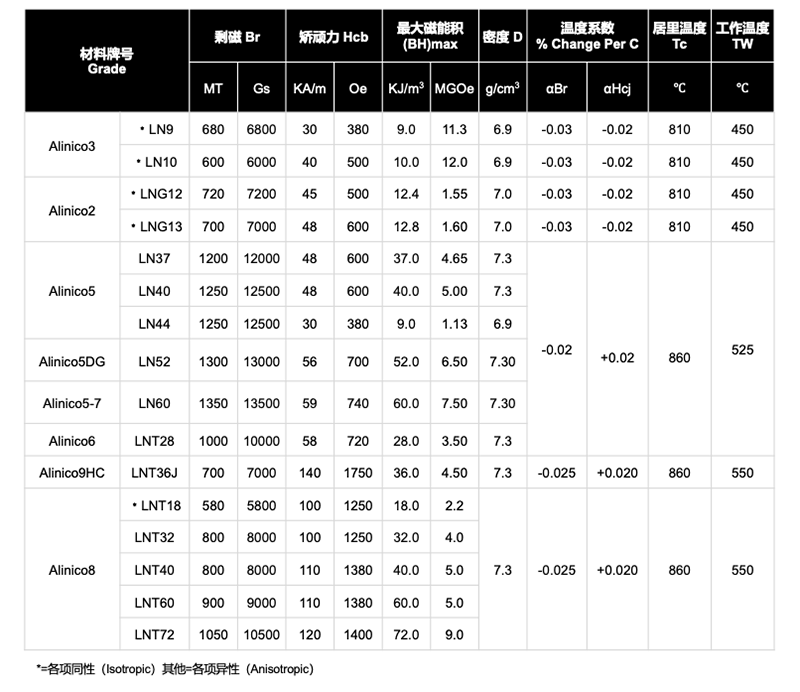
Introduction to AlNiCo permanent magnet materials
2023-11-15 15:08Before the invention of rare earth permanent magnet materials in the 1970s, AlNiCo alloys had always been the permanent magnet materials with the strongest magnetic properties. However, because the composition contained strategic metals cobalt and nickel, the cost was high. With the ferrite permanent magnets and With the advent of rare earth permanent magnets, AlNiCo materials have been gradually replaced in many applications. However, in some high-temperature applications and situations with high magnetic stability requirements, AlNiCo magnets still occupy an unshakable position.

1. Alnico permanent magnet material features
Advantages: high residual magnetism, extremely small temperature coefficient, and good corrosion resistance;
Disadvantages: low mechanical strength, poor processability, small intrinsic coercive force, and intolerance to vibration and impact.
According to the low coercivity of alnico permanent magnet materials, in order to enhance its anti-demagnetization ability, the magnetic pole surface is often designed into a long cylinder or long rod shape. At the same time, the reverse magnetic field in the environment where the magnet is used must be strictly controlled to avoid the magnetic steel from being demagnetized. Local irreversible demagnetization or distortion of the magnetic flux density distribution. The demagnetization curve of alnico changes nonlinearly, and the recovery line and the demagnetization curve do not coincide. After magnetization, magnetic stabilization aging treatment is required.

2. Alnico permanent magnet performance grades
Commercial alnico grades can generally be divided into grades 2, 3, 4, 5, 6, 8 and 9, mainly based on magnetic properties and composition. Among them, grades 2, 3 and 4 are isotropic magnets, and the rest are anisotropic magnets. The theoretical maximum magnetic energy product of AlNiCo magnets can reach 30~35MGOe, but in reality, commercial magnets only reach about 1/3 of the theoretical value. If AlNiCo can reach about 80% of the theoretical value like other permanent magnet materials such as ferrite, samarium cobalt and neodymium iron boron, its application prospects will be further expanded due to its excellent corrosion resistance and temperature stability.

3. Alnico magnet production process
Alnico magnets have two processes: [casting] and [sintering]. Casting Alnico has higher performance and is also the mainstream in market applications. However, due to the poor processability of cast Alnico, sintered Alnico will be used for small parts, complex shapes or scenes that require uniformity.
The production process of aluminum nickel cobalt casting: batching → smelting → casting → heat treatment → performance testing → mechanical processing → inspection → packaging. Cast alnico products are mainly used in measurement and testing, instrument magnets, auto parts, high-end audio, military equipment, aerospace and other fields.
Sintered alnico is produced by powder metallurgy. The production process is: batching→pulverizing→pressing→sintering→heat treatment→performance testing→machining→inspection→packaging. Sintered Alnico is suitable for the production of complex, light, thin and small products, and is mainly used in electronic communications, permanent magnetic chucks, magnetoelectric switches and various sensors.
4. Alnico magnet market status
At present, except for a few foreign companies such as Hitachi Metals, most manufacturers have basically stopped production and turned to other industries, and domestic high-quality AlNiCo magnets have completely filled this demand. The prospects of alnico magnets are inevitably limited by the resource supply and market prices of the two strategic metals cobalt and nickel. At the same time, the alnico production line still has low automation, poor operating environment, and requires a lot of labor. The only way to achieve this is through Improving the level of production line automation, optimizing the level of magnetic circuit and device design, and exploring new application areas will help AlNiCo continue to occupy a place in permanent magnet materials.
